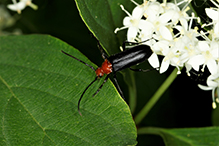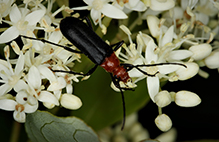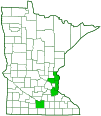America long-horned beetle
(Charisalia americana)
Conservation • Description • Habitat • Ecology • Distribution • Taxonomy
|
|
||||||||||||||
Description |
America long-horned beetle is a relatively rare, moderate sized, flower longhorn beetle. It is the only species in the genus Charisalia. It occurs in the United States east of the Great Plains. Adults are 5 ⁄16″to 7 ⁄16″ long and cylindrical. Males and females are the same size. The head is reddish-orange, angled forward in front, and abruptly constricted in back forming a neck that is visible when viewed from above. The compound eyes are black, small, and deeply notched. The antennae are slender, black, and long, almost as long as the body. The base of each antenna inserted in the notch in the compound eye. The third segment is shorter than the first, the fourth is shorter the third, and the fifth is longer than the third. The fifth through the last segments are moderately to densely covered with very short hairs. On females the antennae are shorter, extending only to about the third abdominal segment. The upper thoracic shield (pronotum) is bell-shaped and wider than long. It is narrow at the front and almost as wide at the base as the base of the hardened wing covers (elytra). It is inflated (arched) on top (dorsally). It has a shallow impression in the middle near the base. The angles at the rear (posterior) corners of the pronotum are very sharp and point outward. It is sparsely covered with very fine pits. It is also covered with short, curved hairs. The elytra are entirely black and elongated, about 2½ times as long as the base is wide. They are parallel from the base to the middle, slightly expanded beyond the middle toward the tip. The tips are distinctly cut off (truncate), and do not cover the very end of the abdomen. The elytra surface is pitted, finely and sparsely near the base and at the tip, coarsely in the middle. It is also moderately covered with short hairs. The legs are slender, entirely black, and covered with fine hairs and pits. The fourth segment (tibia) has a spur at the tip and on males is arced. The last part of each leg (tarsus), corresponding to the foot, is black. The tarsus has five segments but the fourth segment is minute and is concealed within the lobes of the heart-shaped third segment, making it appear that there are only four segments. On the hind leg, the tarsi are slender. The first segment is longer than the second and third segments together. The third segment is split beyond the middle. |
Size |
Total length: 5 ⁄16″to 7 ⁄16″ |
Similar Species |
Habitat |
|
Ecology |
Season |
April to July |
Behavior |
|
Life Cycle |
|
Larva Food |
There are very few recorded sightings of this beetle larvae. It has been collected on a dead and decaying tulip tree stump, and it was reported on a tupelo tree. In Minnesota it was recorded on a “decaying 'sourgum'”. |
Adult Food |
There are very few recorded sightings of this beetle adult. It has been collected or recorded on dogwood, rose, viburnum, and cow parsnip. |
Distribution |
||
|
Sources |
|
| 7/1/2025 | ||
Occurrence |
||
|
||
Taxonomy |
|
Order |
Coleoptera (Beetles) |
Suborder |
Polyphaga (Water, Rove, Scarab, Long-horned, Leaf, and Snout Beetles) |
Infraorder |
Cucujiformia |
Superfamily |
Chrysomeloidea (leaf beetles and allies) |
Family |
Cerambycidae (longhorn beetles) |
Subfamily |
Lepturinae (flower longhorn beetles) |
Tribe |
Lepturini |
Genus |
Charisalia |
Subordinate Taxa |
|
|
|
Synonyms |
|
Leptura americana Stenura americana Strangalia americana |
|
Common Names |
|
America long-horned beetle |
|
Glossary
Elytra
The hardened or leathery forewings of beetles used to protect the fragile hindwings, which are used for flying. Singular: elytron.
Pronotum
The exoskeletal plate on the upper side of the first segment of the thorax of an insect.
Tarsus
On insects, the last two to five subdivisions of the leg, attached to the tibia; the foot. On spiders, the last segment of the leg. Plural: tarsi.
Tibia
The fourth segment of an insect leg, after the femur and before the tarsus (foot). The fifth segment of a spider leg or palp. Plural: tibiae.
Visitor Photos |
||
Share your photo of this insect. |
||
This button not working for you? |
||
Alfredo Colon |
||
 |
 |
|
MinnesotaSeasons.com Photos |
||
|
||
|

Slideshows |
|

Visitor Videos |
||
Share your video of this insect. |
||
This button not working for you? |
||
|
Other Videos |
||
|

Created: 11/13/2018 Last Updated: © MinnesotaSeasons.com. All rights reserved. |



